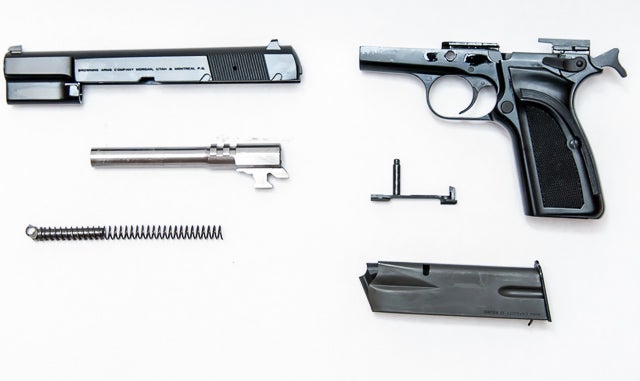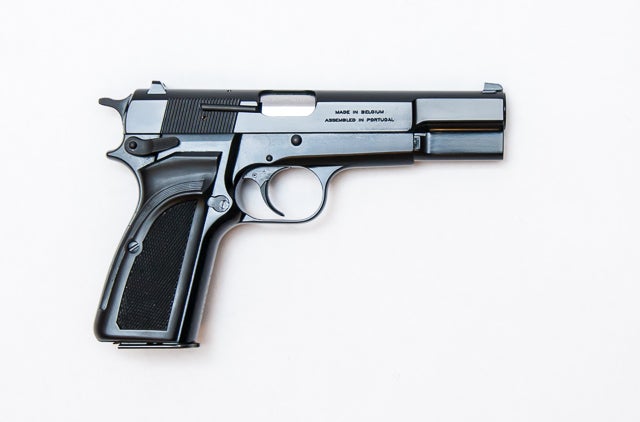The Browning Hi-Power is a creation of the famous firearm designer John Browning, along with the legendary 1911 pistol. This handgun was designed in the 1920s and although less popular than the 1911 (at least in the USA) it has been continuously manufactured from 1935 until now and served as a standard service pistol in the armies of more than 50 nations. The Hi Power’s latest model, the Mark III, features an ergonomic grip, cast frame, forged slide, epoxy coating as well as a firing pin safety.
While working on the Hi-Power design, John Browning could not use any of his previous innovations used in the 1911 design. The sale of the patents to Colt prevented this. As a result the Hi-Power is very different from the 1911.Thanks to the genius of its creator it lacks some of the problems of the famous predecessor. It is much easier to field strip and functions with a wider variety of ammunition. Current models work perfectly with hollow point ammunition.
After Brownings death in 1926 the Hi Power design effort was turned over to the Belgian small arms designer Dieudonné Saive after the Colt patents expired in 1928.
Specification
In early 1920s the French government announced a tender for a new handgun for their police force and military. The requirements were as follows: it should be compact, have a magazine capacity of at least 10 rounds, have an external hammer, external safety, be simple to fieldstrip and fire a caliber of 9mm or larger.
FN Herstal won the contract after the completion of the final design of Saive.
| Hi-Power Mark III technical spec | |
|---|---|
| Caliber | 9mm, .40 S&W |
| Barrel length | 4 5/8” (117.5mm) |
| Overall length | 7 3/4” (196.8mm) |
| Height | 5.02” (127.5mm) |
| Width | 1.4” (36mm) |
| Sight radius | 6 5/16” (160mm) |
| Frame | Cast steel |
| Safety devices | Ambidextrous external safety, magazine disconnect, firing pin block |
| Weight (empty) | 2lb 0oz |
| Capacity | 13 (9mm), 10 (.40S&W) + 1 |
| Trigger action | Single Action |
| Trigger pull | ~ 7.5lb |
| Pressure rating | Regular only |
Unique features
The Hi Power Mark III is an update of the previous Mark II model that came out in 1988. For several years it has been going through a fine tuning process with features added and removed. The model III I reviewed had the following:
Ergonomic grip covers
The grip panels have a raised ledge for the thumb that supposed to ensure a proper grip. I found that the ergonomics of the panels are more suitable for one handed shooting. Using a two hand grip (which is a majority of times for me) is not that comfortable because the thumb rest causes the weak hand thumb to ride on top of the thumb rest. People have different hand sizes and different grips so your experience may be different than mine.
Ambidextrous external safety
The safety lever is large, conveniently located and can be easily manipulated on and off using either hand. It can be useful for left handed shooters.The slide lock and the magazine release are still available only for the left side.
Black mate epoxy finish
The gun has a unique black epoxy finish that makes it look beautiful. It is smooth to touch and looks great when the gun is buffed up. Because I had the gun for a limited time I did not have a chance to evaluate how good it protects against corrosion, dents, and scratches.
Magazine ejection spring
The magazine has a small spring that’s compressed when inserted into the magwell. When the release button is pressed, the magazine literally flies out of the gun.

It’s an interesting feature but, in my opinion, isn’t very practical. In normal circumstances the weight of the metal magazine is usually enough to get it moving. In the case of a malfunction the spring is not strong enough to eject the magazine and it will require manual handling as with any other gun.
My impressions
Ergonomics: ***
[-] As I pointed out already, the grip is more convenient for a one handed grip. The thumb support is located too low for a two handed grip (although we all have different hand size, so your experience may vary).
[-] While the HP does have an ambidextrous safety, it does not have an ambidextrous slide release or magazine release. A quick search yielded no aftermarket solution online.
[+] The safety lever is large, conveniently located and can be engaged/disengaged easily with either hand.
Shootability: ***
Trigger
[-] The trigger is way too heavy for a single action. From what I read it is by design, due to the magazine safety feature (which I personally do not like in a first place). The trigger pull can be greatly improved by having a gunsmith remove the mag safety.
[-] The trigger does not provide any tactile indication of a reset. In other handguns I’ve had a chance to shoot there has always been a click you could feel with your trigger finger when the trigger is reset and the handgun is ready for another shot. In the Hi-Power the trigger is reset somewhere mid-way to being fully released, but there is no tactile indication. You can memorize the location after shooting the HP enough to become very familiar with it. Knowing when the trigger is reset is critical to master the double tap and fast shooting in general.
[+] As it would be expected from a single action gun, the trigger has a short pull.
[+] The trigger is also very crisp and gives very clear indication when the sear is about to release.
Sights
The Hi-Power Mark III comes with slightly larger sights compared to previous models. They do allow a fairly quick sight picture acquisition, but nothing out of ordinary. It would be fair to say they do their job adequately.
Recoil/Balance
[-] I was surprised to see that the gun, while being much heavier, has similar recoil compared to the “plastic guns” so prevalent these days. I own both a (Glock 19 and M&P). Usually heavier guns have lower recoil, but not in this case. Saying that, the recoil is not out of ordinary and should be manageable even for shooters with smaller hands.
Capacity
[-] For the times it was designed for it had an impressive 13 + 1 magazine capacity. For modern times it’s on the lower end for a full size 9mm pistol.
Accuracy
[+] When I took it to a range and shot it at a regular distance of 7-10 yards I didn’t notice much difference in accuracy between the Hi Powers 4.5” barrel and the Glock 19s 4.0” barrel. It seems to be a limitation of the shooter, so I took it back for a greater challenge. I shot both guns at standard 8” paper targets at 100 yards from a bench. At this distance the additional 0.5” of barrel length showed a clear advantage. With the Glock I was able to get only 1 out of 10 rounds on paper at this distance.The Browning put 5 out 10 in the target. (obviously you can see that shooting a handgun at 100 yards is not my thing).
Maintenance: ****
[+] The 1930s handgun can be disassembled as easy as any modern polymer gun such as a Glock or M&P. The cleaning and lube is also straight forward.

Concealability: *
This is a full size handgun designed for military and police use. It is heavy and long, although fairly thin. If you are looking for a concealed carry pistol, this is not a good choice.
Reliability: ****
I haven’t had a chance to shoot a great deal with this gun, my experience is limited by a couple of trips to the range where I fired about 500 rounds through it. I used different types of ammo: cheap steel cased Wolf, mid-range FMJ Federal, JHP Hornady Critical Defense. All worked flawlessly. I had zero malfunctions.
Accessories: ****
While Hi Powers are not as popular as 1911s or Glocks, they’ve been in constant use and production since the 1930s. As a result there is a good selection of aftermarket parts and accessories for this handgun. Holsters are available from any major manufacturer (e.g. Falco, Blade-Tech, DC Holsters, Bianchi, Galko, etc.). Crimson Trace produces their laser grip for it. Sights are available also. Trigger reduction springs, and other parts are available as well.
Cost effectiveness: **
Similar to 1911s the High Power is less about practical use and more about collector value and owning a piece of history. This is reflected in its price – the MRSP is $1,070, which is on the high side for a handgun. The street price is of course $150 or so less than the MSRP.
Conclusion
With almost 90 years of history it cannot beat modern firearms in terms of capacity, concealability, and reliability but still demonstrates good performance.
It is not a practical gun. For each application you can find a better analogue among modern handguns. It is too heavy and bulky for concealed carry. Its heavy trigger prevents optimum performance. The unnecessary magazine safety and low capacity makes one question its utility for home defense or as an issued weapon for military and law enforcement.
In my opinion, the biggest value of this gun is in its history. It is a beautiful piece of machinery that has a long and remarkable history in use in different parts of the world. Every serious firearm collector or firearm history enthusiast should have one.
 Your Privacy Choices
Your Privacy Choices
